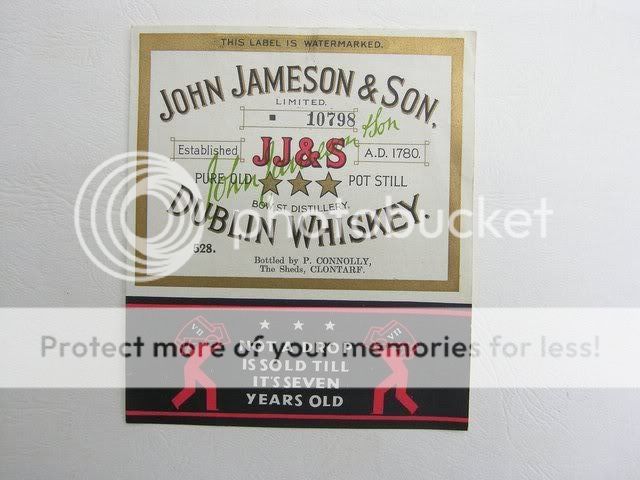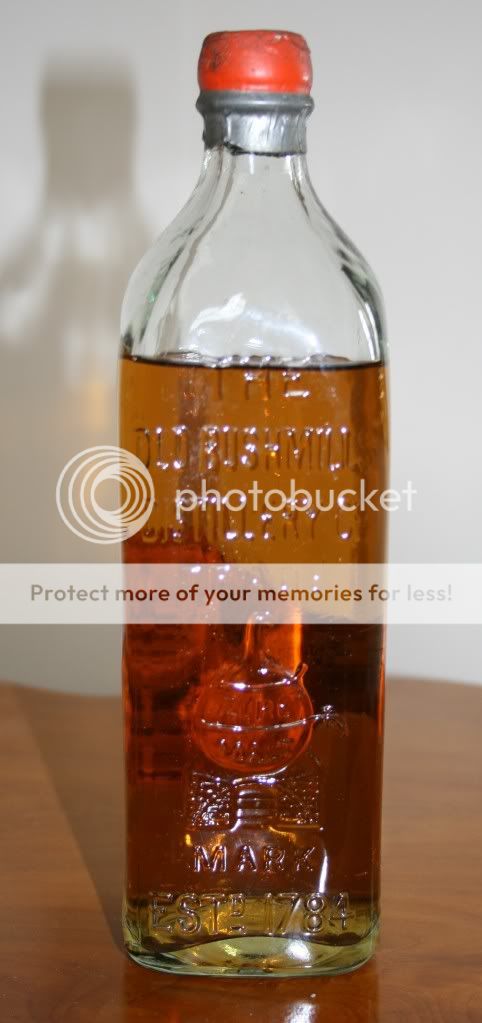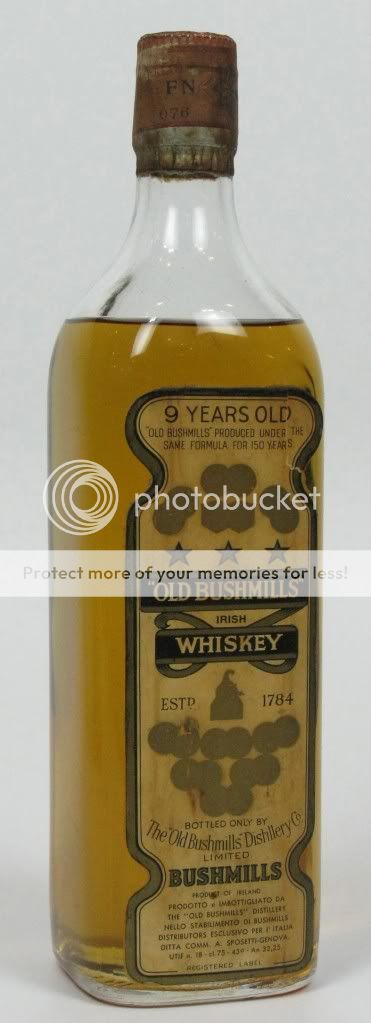NOTE: This forum is no longer active. This is an archive copy of the forum as it was on 10 March 2018.
Exclusive irish whiskey in the 1910s
12 posts • Page 1 of 1
Exclusive irish whiskey in the 1910s
Hi! I am writing a crime novel set in Norway in 1916. My
detective prefers irish whiskey of the more exclusive kind. I
have a dispute with my editor about what would be considered
exclusive irish whiskey in the 1910s. Would Jameson be in this
group?
- Teike
- New Spirit
- Posts: 3
- Joined: Thu Nov 06, 2014 12:38 pm
Re: Exclusive irish whiskey in the 1910s
Jameson was available back then but there were 2 of them.
William Jameson and John Jameson operated independent of each
other. Both would have been common at the time.
If you were looking for something exclusive at the time I'd recommend Nicholas Devereaux Bishop's Water Whisky in Wexford or Cassidy's in Monasterevan(I don't know if they used the 'E' in whiskey or not.
I know Devereaux's spelt it Whisky, they also stopped making whiskey at the outbreak of World War 1(1914) but they would have been supplies for a few more years.
If you were looking for something exclusive at the time I'd recommend Nicholas Devereaux Bishop's Water Whisky in Wexford or Cassidy's in Monasterevan(I don't know if they used the 'E' in whiskey or not.
I know Devereaux's spelt it Whisky, they also stopped making whiskey at the outbreak of World War 1(1914) but they would have been supplies for a few more years.
Four blessings upon you - Older whiskey - Younger women - Faster
horses - More money
https://twitter.com/potstillwhiskey
https://facebook.com/potstillwhiskey/
https://www.instagram.com/potstillwhiskey/
https://twitter.com/potstillwhiskey
https://facebook.com/potstillwhiskey/
https://www.instagram.com/potstillwhiskey/
-

Good Whiskey Hunting - Fully mature Cask
- Posts: 1832
- Joined: Tue Dec 01, 2009 11:43 pm
- Location: Wexford
Re: Exclusive irish whiskey in the 1910s
Good Whiskey Hunting wrote:Jameson was available back then but there were 2 of them. William Jameson and John Jameson operated independent of each other. Both would have been common at the time.
If you were looking for something exclusive at the time I'd recommend Nicholas Devereaux Bishop's Water Whisky in Wexford or Cassidy's in Monasterevan(I don't know if they used the 'E' in whiskey or not.
I know Devereaux's spelt it Whisky, they also stopped making whiskey at the outbreak of World War 1(1914) but they would have been supplies for a few more years.
Thank you very much for your answer! I will check these two up. Would be nice to have my detective drink an exclusive irish whiskey not very common today, so I will probably change to one of these
- Teike
- New Spirit
- Posts: 3
- Joined: Thu Nov 06, 2014 12:38 pm
Re: Exclusive irish whiskey in the 1910s
Teike wrote:Hi! I am writing a crime novel set in Norway in 1916. My detective prefers irish whiskey of the more exclusive kind. I have a dispute with my editor about what would be considered exclusive irish whiskey in the 1910s. Would Jameson be in this group?
Hi Teike,
Best of luck on the Novel. Irionically the timing of your novel is the last hurray for the great Irish whiskey industry as once World War 1, prohibition and Irish Rising (1916) & Irish Civil War kicked in the death knell was well and truly on the way and a total decline of the industry by the early 20's. This was also the time when Blends started to gain more wide spread appeal as they were cheaper and for some palates milder and more approachable etc. I'll try and give you some food for thought.
just a word on Cassidy's & Devereux, although I do like the names, these would have been small opperations and mainly supplied the locality and possibly branched out to some bigger cities in the United Kingdom as Ireland was a part of at the time. Max Annual out put for Deveraux's was 110,000 gallons which is good but still quite small. Although Cassidy's was just above 200,000 which would be enough for export but there has been historical accounts to suggest they supplied locally mainly. The big Dublin Distilleries would have had actual output near or above 1million gallons per annum. So if you want to be factually correct you may need to avoid the small local distilleries but the names could well be thing to go by. However, there is no reason why any whiskey Brand could not have found their way around the world though as that is how the UK worked. everything dispatched by ship to the 4 corners.
The main 4 irish Distilleries of the time were based in Dublin and were known as the "The Big 4" These were John Jameson & Son, James Power & Son, William Jameson & Co and George Roe but part of the DDC (Dublin Distillers Company) at the time. DDC was an almangum of a few distilleries and they continued to bottle under their own names and it was a bit messy. Only J Jameson & Powers survived.
Jameson was biggest internationally back then as it is today. Jameson only sold Whiskey by the barrell back then. Therefore in Ireland each and every public bar bottled their own Jameson (Under a standardise Jameson label) but added their own name on it.
i.e.

And they shipped abroad in the same manor too. To be honest I woud not know the workings of the Norweigen market of the time but we can take an educated guess on the back of the exports to the UK & US. So in the States there was Companies such as Taylor & Co in New York who Marketed it in 2 forms, 3Star which was the regular version (Probably anywhere between a 7-12year old whiskey) & the more up market 5star which was thought to be over 20years old.
This is an actual 5 Star from the period. Note the majority of whiskey of this time had driven corks lead capsules and imperfections in the bottle like small air bubbles.

Powers was huge in Ireland and remaind the top selling Irish whiskey until Jameson only over took it in the last decade or so. They were the first Irish whiskey company to bottle at source (1886) and labeled with the now famous gold label and it was just know as Gold Label for some time. They also invented the Mini or Baby Powers (1900) as it was called at the time.
However Bushmills was also very big at the time and they also did bottle their own. It is arguable that they may have been bigger in Europe than Jameson but these statements are hard to authenticate.
Theirs was a more normal issue of one main brand and seemed to excell at their "Pure Malt" which got many plaudits at the time. As reported by Bushmills themselves. "The repeated successes at Exhibitions generated great excitement" Winning awards at the likes of the Cork Industrial Exhibition in 1883, The only Gold medal in the Exposition Universelle Paris 1889 (Where the Shah of Persia was recorded as recieving a bottle of Bushmills), Chicago 1893, St Louis 1904 and the London - Franco (British) Exhibition of 1908. It's seems by far the most decorated Irish whiskey of this time.
This is the imbossed bottle typical of the time but with a label not too unsimilar to this, but with Pure Malt rather than an age statement.
Notice their claim to fame was 1784 back then and not 1608 as the PR guys would like you to believe now !!!!


However there were other popular brands which maybe a bit obtuse to non Irish whiskey aficinado's like Winston Churchills favourite Irish whiskey ... Locke's Pure Pot Still. Or H.S. Persse Very Fine Old which was a renowned Pot Still from Galway city. William Jameson was huge in the US and was also found in the UK to a lesser extent as they concentrated their efforts on the export to US.
Old Comber (silent b) Pot Still from Comber Co Down in Norther Ireland was a well respected pot still of the time and survived till the early 1950's. As was Dunvilles whiskey from the Royal Irish Distillery in Belfast but they tyended to concentrate on Blends and had a good name for quality whisky.
and of Cocurse I nearly forgot another well known distillery of the time and still popular Tullamore Dew
others
McConnell's Pot Still (Cromac Distillery Belfast)
Midleton Whiskey (Midleton Co Cork)
Cork Distillers Co Irish Whiskey (Paddy ) but not technically named Paddy till 1912.
Allman Pot Still (Bandon Distillery)
Burke's of Dublin & Liverpool (independent Bottlers)
there are many more but brand names of the time are many and varied.
If you want any further reading on any of these let us know and we'll try and point you in the right direction.
Sláinte Adrian
- IrishWhiskeyChaser
- Site Admin
- Posts: 2910
- Joined: Tue Mar 17, 2009 1:37 pm
- Location: A Dark Dunnage somewhere in Galway
Re: Exclusive irish whiskey in the 1910s
One further thought - but IWC might confirm if the dates are
applicable - were any of the spot range around at the time -
Green Spot, Yellow Spot, Red Spot or Blue?
They were Jameson whiskeys but the Yellow Red and Blue were aged and would, I guess, have been exclusive at the time.
They were Jameson whiskeys but the Yellow Red and Blue were aged and would, I guess, have been exclusive at the time.
- IainB
- Hogshead
- Posts: 976
- Joined: Thu Jul 02, 2009 3:48 pm
Re: Exclusive irish whiskey in the 1910s
IainB wrote:One further thought - but IWC might confirm if the dates are applicable - were any of the spot range around at the time - Green Spot, Yellow Spot, Red Spot or Blue?
They were Jameson whiskeys but the Yellow Red and Blue were aged and would, I guess, have been exclusive at the time.
I think you could be right Iain, They too would have been around at that time with Blue and Red spots being at the real high end. Further too would have Redbreast (also known as the Priests bottle as they were among the few who could afford it at the time
Sláinte Adrian
- IrishWhiskeyChaser
- Site Admin
- Posts: 2910
- Joined: Tue Mar 17, 2009 1:37 pm
- Location: A Dark Dunnage somewhere in Galway
Re: Exclusive irish whiskey in the 1910s
IainB wrote:One further thought - but IWC might confirm if the dates are applicable - were any of the spot range around at the time - Green Spot, Yellow Spot, Red Spot or Blue?
They were Jameson whiskeys but the Yellow Red and Blue were aged and would, I guess, have been exclusive at the time.
I think you could be right Iain, They too would have been around at that time with Blue and Red spots being at the real high end. Further too would have Redbreast (also known as the Priests bottle as they were among the few who could afford it at the time
Redbreast was a Jameson bottled by Gilbeys and came into being circa 1912 possibly due to the colour of a previous unreckonised brands label and of course the now famous bottle shape.
They also had a brand prior to that which was a "John Jameson & Son’s ‘sole make’ pure and unblended Irish whiskey. Every bottle of Castle Grand Whiskey had a label certifying that it was Jameson’s and upwards of 6 years old."
Sláinte Adrian
- IrishWhiskeyChaser
- Site Admin
- Posts: 2910
- Joined: Tue Mar 17, 2009 1:37 pm
- Location: A Dark Dunnage somewhere in Galway
Re: Exclusive irish whiskey in the 1910s
IrishWhiskeyChaser wrote:
Redbreast was a Jameson bottled by Gilbeys and came into being circa 1912 possibly due to the colour of a previous unreckonised brands label and of course the now famous bottle shape.
Do you know if there was a series of whiskeys with birds names at this time? I remember Leo saying the the bonded was into birds (of the feathered variety). Could there have been something similar to the Spots where different birds represented different ages, I'm only guessing here of course!
Four blessings upon you - Older whiskey - Younger women - Faster
horses - More money
https://twitter.com/potstillwhiskey
https://facebook.com/potstillwhiskey/
https://www.instagram.com/potstillwhiskey/
https://twitter.com/potstillwhiskey
https://facebook.com/potstillwhiskey/
https://www.instagram.com/potstillwhiskey/
-

Good Whiskey Hunting - Fully mature Cask
- Posts: 1832
- Joined: Tue Dec 01, 2009 11:43 pm
- Location: Wexford
Re: Exclusive irish whiskey in the 1910s
Just a few comments that may be of interest:
1. Irish Whiskey was predominantly spelt with an 'e' at the time.
This would have been the case from about 1870 when much of the Scotch Whisky being produced was of very poor
quality. For exportation purposes, Irish distillers therefore wished to differentiate their product from the poorer
Scotch Whisky, thus they added the 'e' to mark the crucial distinction;
2. There was a strong temperance movement evolving in Norway and neighbouring countries during this period and
in 1916 (the time of your novel !!!!), Norway prohibited distilled beverages (followed by wine and beer in 1917). The
prohibition on distilled beverages lasted until 1923.
Accordingly, your detective might have been fortunate to get his hands on any brand of whiskey - let alone an exclusive
high-end Irish variety.
1. Irish Whiskey was predominantly spelt with an 'e' at the time.
This would have been the case from about 1870 when much of the Scotch Whisky being produced was of very poor
quality. For exportation purposes, Irish distillers therefore wished to differentiate their product from the poorer
Scotch Whisky, thus they added the 'e' to mark the crucial distinction;
2. There was a strong temperance movement evolving in Norway and neighbouring countries during this period and
in 1916 (the time of your novel !!!!), Norway prohibited distilled beverages (followed by wine and beer in 1917). The
prohibition on distilled beverages lasted until 1923.
Accordingly, your detective might have been fortunate to get his hands on any brand of whiskey - let alone an exclusive
high-end Irish variety.
- The Nectar Collector
- New Spirit
- Posts: 7
- Joined: Fri Feb 07, 2014 9:16 am
Re: Exclusive irish whiskey in the 1910s
Thank you all for all the useful information, comments and
answeres. I will try to make a decision of what whiskey my
detective preferred. I guess it will not be easy, but I
certainly have a lot more brands to choose from now. I will let
you know. It is funny, but because of the prohibition in 1916,
many doctors in Norway prescribed distilled beverages for their
patients on receipt. Some of the doctors even got a reputation
for being a liquor-doctor (brennevinsdoktor), and some of them
lost their right to prescribe. Fortunately, my detectives
companion happens to be a doctor, so hopefully they will get
hand on some irish whiskey at least

- Teike
- New Spirit
- Posts: 3
- Joined: Thu Nov 06, 2014 12:38 pm
Re: Exclusive irish whiskey in the 1910s
I think it's fair to say Teike that you have some good
information there to work with! Just like Irish Whiskey, the
'Nordic Noir' genre appears to be going from strength to
strength so best of luck with the novel.
All the best,
John.
All the best,
John.
Always carry a flagon of whiskey in case of snakebite and
furthermore; always carry a small snake - W.C. Fields et al.
-

John - Hogshead
- Posts: 641
- Joined: Tue Mar 24, 2009 1:32 pm
- Location: Dublin Mountains!
Re: Exclusive irish whiskey in the 1910s
Very interesting information, great for newbies like myself.
- DAISY
- New Spirit
- Posts: 3
- Joined: Thu Apr 14, 2016 1:59 pm
12 posts • Page 1 of 1
